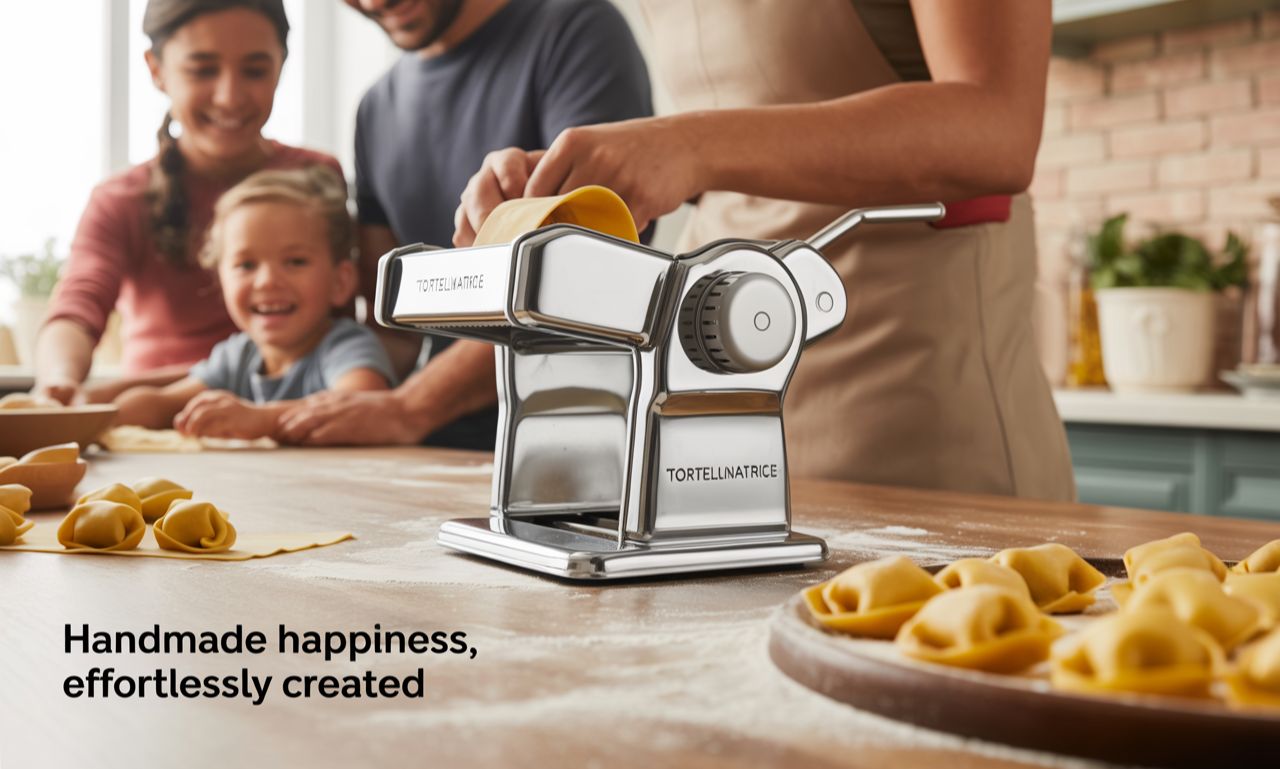Rich flavors, fresh ingredients, and artisanal techniques—particularly with pasta—have made Italian food renowned throughout the world. Tortellini has a distinct place among the numerous popular types of pasta. Making these delicate, ring-shaped stuffed pastas by hand takes a lot of effort, but they are a mainstay in Emilia-Romagna. A ground-breaking device created to automate and refine the manufacture of tortellini is the tortellinatrice.
In this in-depth guide, we’ll explore:
✔ What a tortellinatrice is and how it works
✔ Key features that make it indispensable
✔ Benefits for home cooks and professional chefs
✔ Top models on the market
✔ How it compares to handmade tortellini
✔ Maintenance and care tips
You’ll see why this machine is revolutionizing pasta-making by the end, whether it’s for large-scale production or small kitchens.
1. What Is a Tortellinatrice?
To ensure consistency, speed, and uniformity, a specialized pasta machine called a tortellinatrice (plural: tortellinati) automatically shapes and folds pasta. In contrast to manual techniques, which necessitate expert hands to fold every piece, this machine expedites the procedure without sacrificing authenticity.
How It Works:
- Dough Feeding: A thin sheet of pasta dough is fed into the machine.
- Filling Injection: A precise amount of filling (like ricotta, meat, or spinach) is deposited onto the dough.
- Cutting & Shaping: Blades cut the dough into squares, then mechanical arms fold and seal each piece into the classic tortellini ring shape.
- Output: Finished tortellini are ejected, ready for cooking or freezing.
Ideal Users:
- Home cooks passionate about authentic pasta
- Restaurants needing high-volume production
- Food manufacturers supplying gourmet pasta
2. Key Features of a High-Quality Tortellinatrice
Not all machines are created equal. Here’s what to look for:
A. Adjustable Dough Thickness
- Mimics handmade pasta by allowing customization (0.5mm to 2mm).
- Ensures the perfect balance of tenderness and structure.
B. Precision Filling Dispenser
- Prevents over- or under-filling, a common issue in manual folding.
- Works with both soft (ricotta) and dense (meat) fillings.
C. Speed Settings
- Home models: 10–30 tortellini per minute.
- Commercial models: 100+ per minute.
D. Durability & Materials
- Stainless steel components resist wear and corrosion.
- Food-grade plastics for safe, easy cleaning.
E. Portability & Size
- Compact models for home kitchens vs. industrial-scale machines.
3. Benefits of Using a Tortellinatrice
Consistency & Professional Results
- Every tortellino is identical in shape, size, and filling—crucial for restaurants.
Time-Saving Efficiency
- Replaces hours of hand-rolling with minutes of automated production.
Cost-Effective for Businesses
- Reduces labor costs and waste from imperfect handmade batches.
Hygienic & Safe
- Minimizes human contact, reducing contamination risks.
Versatility
- Many models can also make ravioli, cappelletti, or agnolotti with attachment swaps.
4. Top Tortellinatrice Models in 2024
| Model | Type | Speed | Best For | Price Range |
|---|---|---|---|---|
| Imperia PastaMatic | Home | 20/min | Enthusiasts | $200–$400 |
| Marcato Atlas 150 | Home/Pro | 30/min | Small restaurants | $500–$800 |
| Italpast G6 | Commercial | 120/min | Large kitchens | $3,000+ |
Pro Tip: For home use, Imperia offers the best balance of affordability and quality.
5.Tortellinatrice vs. Handmade Tortellini: Which Wins?
| Factor | Machine-Made | Handmade |
|---|---|---|
| Speed | ⚡ Fast (100+/min) | 🐢 Slow (10–15/min) |
| Consistency | ✅ Perfectly uniform | ❌ Slight variations |
| Labor | Low | High skill required |
| Authenticity | Good | Excellent (traditional) |
Verdict: Machines excel in efficiency, but handmade retains artisanal charm.
6. Maintenance & Cleaning Tips
To extend your machine’s lifespan:
- Disassemble removable parts after each use.
- Hand-wash with warm water (avoid dishwashers).
- Dry thoroughly to prevent rust.
- Lubricate gears with food-safe oil monthly.
7. FAQs About Tortellinatrice
Q: Can I use gluten-free dough?
A: Yes, but adjust thickness (gluten-free dough is more fragile).
Q: How long do these machines last?
A: 5–10+ years with proper care.
Q: Are attachments interchangeable?
A: Often—check compatibility with your model.
Conclusion: Is a Tortellinatrice Worth It?
Tortellinatrice is a game-changer for chefs, pasta enthusiasts, and food enterprises. By combining technology and tradition, it produces faultless tortellini in large quantities without compromising quality. The machine’s speed, uniformity, and convenience of use make it an essential tool in contemporary kitchens, even though purists might prefer handcrafted.
Are you prepared to improve your pasta-making? Take a look at the best models now and effortlessly serve real Italian tortellini!
